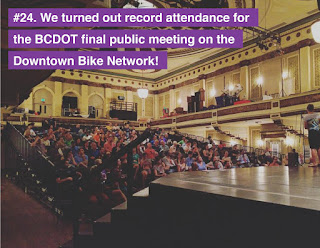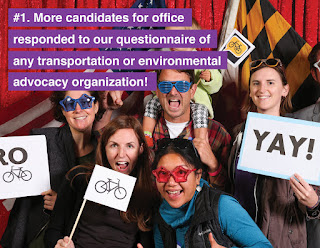 |
| Liz Cornish at the Annual Meeting in Bikemore's 5th year (photo: Philipsen) |
- Baltimore City finally launched its bike share program which differentiates itself from similar programs in other cities by offering about 50% electric bikes which make it much easier to get up and down those Baltimore hills
- The Maryland Avenue "cycle track", a two-way separated and protected bike lane also went from talk to reality and opened in November '16 only to be cut-off again a few days later by a sinkhole on Cathedral Street. The repair is now finally completed and the track can be fully enjoyed end to end
- the City has marked various east-west roads with bike lanes and the green bike crossing paint that provide access to the north south cycle tracks on Maryland and Guilford Avenues
- Bikemore was able to hire staff and create a more robust organization by forming a c4 organization which makes it more nimble in campaigning for bikes and less constrained than the still existing c3 non-profit
 |
| Green bike crossing markings can be seen across Baltimore |
Currently Bikemore is working closely on a Council bill to be introduced by councilman Ryan Dorsey requiring a Complete Streets policy and design guidelines. Dorsey was present when Cornish explained that she is working on putting the bill on a broad footing considering wide community input, promising "a coalition unlike any Baltimore has ever seen". Complete Streets aim to balance all users of streets better than the past "car-first" approaches that left sidewalks narrow and bicyclists to fend for themselves while buses are stuck behind cars and trucks.
Other Bikemore efforts are small in scale but help making bicycling easier across all ages and neighborhoods for example through installation of bike racks in front of businesses and institutions or having mobile bike repair shops come into areas that have no bike shops. "80% of households have a bike sitting around somewhere, often in disrepair". The mobile shops help to get the wheels moving again. Encouraging active transportation to get to the local farmers markets, Bikemore also organizes Bike to Market days.
 |
| Bikemore: Working with allies and building coalitions (Photo: Philipsen) |
One of the physical challenges Bikemore wants to attack is the JFX which presents a barrier in many places."The big jump" project is working on solutions how to get from one side to the other. Other projects are the Baltimore Bike Network Plan and the Baltimore Greenway Trails Network which according to Cornish still has 10 miles of gaps to be filled. Cornish called the Greenway project a "public health project". An application for health grants are in the works. Cornish also wants to address matters further of from the bicycle such as land-use. A first step in that direction was collaboration on the now adopted zoning code.
Of the Bike Network Plan she said "that $30 million could do the whole thing" and compared that cost to the cost of a single bridge leading to HarborPoint ($11 million). Obviously, the $30 million won't be provided in one chunk and Bikemore is working on getting the required $2 million local matches to get access to federal grants to build the network.
One of the non-physical challenges that keep Cornish up at night is the widespread notion that bicycling is a luxury for whites, specifically the much maligned millenials and "creative class". A look over the audience of maybe 60 folks confirmed that most were, indeed, white, but by far not all. Cornish and Bikemore are working hard on crossing boundaries of race and class. The extension of the bikeshare program this spring will help by expanding outside the downtown core where the initial bike share stations were clustered. Baltimore's new Delegate Robbyn Lewis is also a Bikemore Board member and a strong ally in the effort.
WE AIM TO PUT PEOPLE BEFORE CARS AND EXPAND ACCESS TO OPPORTUNITY FOR ALL BALTIMOREANS (website slogan)Another supporter is Board member Luis Cardona who works for the Downtown Partnership and brings his experience from Boston to Baltimore. In Boston he had worked with the Boston Cyclists Union t on making the city more bike friendly. The legendary Mayor Thomas Menino was a big supporter, Cardona recounted.
A quiet bystander at the gathering was Stuart Sirota, Assistant Secretary at the Maryland Department of Planning until very recently and now a principal at Alta Planning and Design, a consultant firm which became nationally known for bicycle planning and bike-share. The firm offers a free webinar on 5/11 under the title "Advancing the intersection of health, equity and transportation", exactly what Bikemore is trying to do.
Bicycling in Baltimore is one of the things that can be seen through the cynical lens of the divided Baltimore as someting that heightens the divisions or as a tool of pulling people together as an equalizer. Bikemore is clearly working to do the latter.
Klaus Philipsen, FAIA
Related articles on this blog:
Complete Streets 2.0
Baltimore's Bikeshare and "the White L"
What is LTS in bike network planning?
Will 2016 really be Baltimore's "year of the bike"?
Bikemore slides showing their 2016 work (all created by Bikemore):
Now available in bookstores and online:
Klaus Philipsen, Baltimore:
Reinventing an Industrial Legacy City
Cat # / ISBN:
Y308725 / 9781138230361














No comments:
Post a Comment